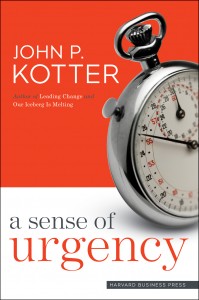 John Kotter believes the “single biggest error people make when they try to change” is the failure to “create a high enough sense of urgency among enough people to set the stage for making a challenging leap into some new direction.”
John Kotter believes the “single biggest error people make when they try to change” is the failure to “create a high enough sense of urgency among enough people to set the stage for making a challenging leap into some new direction.”
A Sense of Urgency is Kotter’s attempt to shine light on this glaring omission by defining true urgency over against its opposite (complacency) and its imitator (false urgency).
Lasting Change Begins with Urgency
Kotter begins by making the case that lasting change begins with a sense of urgency. Leaders who understand this truth recognize that great opportunities and hazards are all around them and that critical issues must be dealt with quickly in order for teams to succeed at their goals.
In order to foster a true sense of urgency, leaders paint a picture of reality by revealing how external change affects their business and what internal decisions are needed in order to succeed in a rapidly changing environment.
When true urgency spreads through an organization, leaders prioritize meetings, decisions, and communication, while they simultaneously empower people to take responsibility and implement the necessary strategies for fulfilling the vision.
The Obstacles to Urgency
The obstacles leaders face are complacency and false urgency.
Complacency is widespread in organizations wherever people are satisfied with the status quo. Complacent people are not looking for new opportunities and hazards, choosing instead to focus on what is taking place inside rather than outside the organization.
False urgency is a frenetic pace that is driven by fear of failure, giving the impression that activity is taking place even if productivity suffers. When a false urgency sweeps through an organization, people are active, but also anxious, angry, and tired.
One Strategy, Four Tactics
To counteract complacency or false urgency in an organization, Kotter provides one strategy and four tactics.
The strategy is to win over hearts and minds with a logical case that uses “tactics that communicate not only needs but emotionally compelling needs, that communicate not only new stretch goals, but goals that excite and arouse determination.”
The four tactics are:
- Bring outside reality into groups that are too inwardly focused.
- Behave with true urgency every day. (Model urgency visibly in front of others.)
- Look for upside possibilities in crises. (A crisis is not just a threat, but an opportunity.)
- Confront the problem of “NoNos” – people who habitually resist attempts to change.
The book concludes with strategies for maintaining a sense of urgency over a long period of time. The goal is to create a culture of urgency.
Kotter writes: “With a culture of urgency, people deeply value the capacity to grab new opportunities, avoid new hazards, and continually find ways to win.”
Developing a Sense of Urgency in Your Church
A Sense of Urgency is the kind of leadership book pastors should consult.
It seems like every week brings new bad news regarding the state of evangelical churches. Many denominations and churches are plateaued or declining, filled with church members who are lulled into a sense of complacency due to past successes or overly internal focus. Some congregations recognize the seriousness of the situation, but choose to fill the calendar with frenetic activity that hides the true state of the situation.
Only God’s goodness and grace can change the outcome of a church on the verge of demise, but it is likely that He will utilize a focused sense of urgency as one of the main instruments for bringing about change. It is vital for pastors to show a stark picture of reality and then gather teams to tackle the problems.
From a church perspective, Kotter’s book explains why many denominational meetings and conferences feature pastors giving statistics (“We are declining”) and bad news (“We aren’t making enough disciples” or “We’re losing the next generation,” or “People without access to the gospel are dying and going to hell”).
Leaders instinctively understand the need to create urgency by showing a snapshot of reality. A good leader, however, will ensure that a sense of urgency is created not only by showing reality, but also by giving hope.
The bad news (“We are in a bad state”) must be followed up by good news (“Things can and will be different”) connected to urgent action (“Here’s what we can do”).
A Sense of Urgency will stimulate pastors and church leaders to consider the culture of our congregations and how we can create change.


















